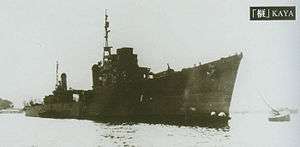Japanese destroyer Kaya (1944)
Japanese destroyer Kaya (榧, "torreya nucifera") was a Matsu-class destroyer built for the Imperial Japanese Navy during World War II.
 Japanese destroyer Kaya (1945) | |
| History | |
|---|---|
| Name: | Kaya |
| Laid down: | 10 April 1944 |
| Launched: | 30 July 1944 |
| Completed: | 30 September 1944 |
| General characteristics | |
| Class and type: | Matsu-class destroyer |
| Displacement: |
|
| Length: | 100 m (328 ft 1 in) |
| Beam: | 9.35 m (30 ft 8 in) |
| Draft: | 3.3 m (10 ft 10 in) |
| Propulsion: |
|
| Speed: | 27.8 knots (32.0 mph; 51.5 km/h) |
| Range: | 3,500 nmi (6,500 km) at 18 kn (21 mph; 33 km/h) |
| Complement: | 211 |
| Armament: |
|
Design and description
The Matsu-class ships were designed as a cheap escort destroyer optimized for mass production. The ships measured 100 meters (328 ft 1 in) overall, with a beam of 9.35 meters (30 ft 8 in) and a draft of 3.3 meters (10 ft 10 in).[1] They displaced 1,282 metric tons (1,262 long tons) at standard load and 1,554 metric tons (1,529 long tons) at deep load.[2]
The ships had two Kampon geared steam turbines, each driving one propeller shaft, using steam provided by two Kampon water-tube boilers. The turbines were rated at a total of 19,000 shaft horsepower (14,000 kW) for a designed speed of 28 knots (52 km/h; 32 mph). They had a range of 4,680 nautical miles (8,670 km; 5,390 mi) at a speed of 16 knots (30 km/h; 18 mph).[3]
The main armament of the Matsu class consisted of three Type 89 127-millimeter (5.0 in) dual purpose guns in one twin-gun mount aft and one single mount forward of the superstructure. They carried a total of twenty-four Type 96 25-millimeter (1.0 in) anti-aircraft guns in four triple and a dozen single mounts. The ships were also armed with four 610-millimeter (24.0 in) torpedo tubes in a single quadruple traversing mount[4] and 36 depth charges.[1]
Construction and career
Kaya was launched by Maizuru Naval Arsenal on 30 July 1944 and completed on 30 September.[5] The ship began performing escort missions beginning in November 1944. In December the ship took part in the bombardment of San Jose before returning to Japan, where it surrendered.[6]
Notes
- Chesneau, p. 196
- Whitley, p. 204
- Jentschura, Jung & Mickel, p. 151
- Whitley, pp. 206–07
- Jentschura, Jung & Mickel, p. 152
- Stille, Mark. "Imperial Japanese Navy Destroyers 1919-45 (2): Asashio to Tachibana Classes", Osprey Publishing, September 17, 2013. Kaya's entry can be viewed online at https://books.google.com/books?id=ESKbAAAAQBAJ&pg=PT67&lpg=PT67&dq=kaya+japanese+destroyer&source=bl&ots=z71gCpFR7K&sig=MWj4yRqDeScIW4Jigf_-_VMMFmA&hl=en&sa=X&ei=-87fU4LFItWzyATOwIHACQ&ved=0CHEQ6AEwDQ#v=onepage&q=kaya%20japanese%20destroyer&f=false
References
- Chesneau, Roger, ed. (1980). Conway's All the World's Fighting Ships 1922–1946. Greenwich, UK: Conway Maritime Press. ISBN 0-85177-146-7.
- Jentschura, Hansgeorg; Jung, Dieter & Mickel, Peter (1977). Warships of the Imperial Japanese Navy, 1869–1945. Annapolis, Maryland: United States Naval Institute. ISBN 0-87021-893-X.
- Whitley, M. J. (1988). Destroyers of World War 2. Annapolis, Maryland: Naval Institute Press. ISBN 0-87021-326-1.